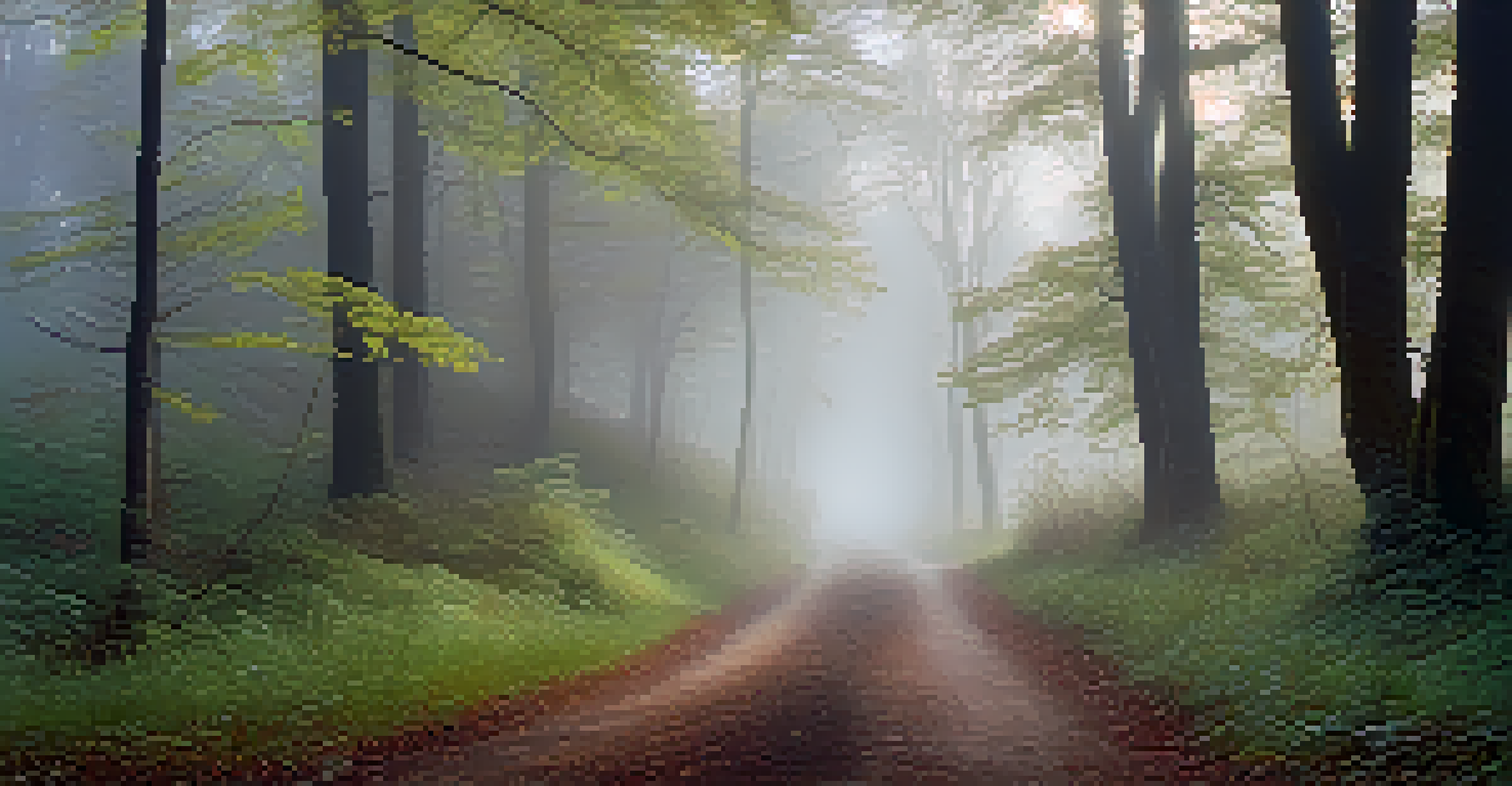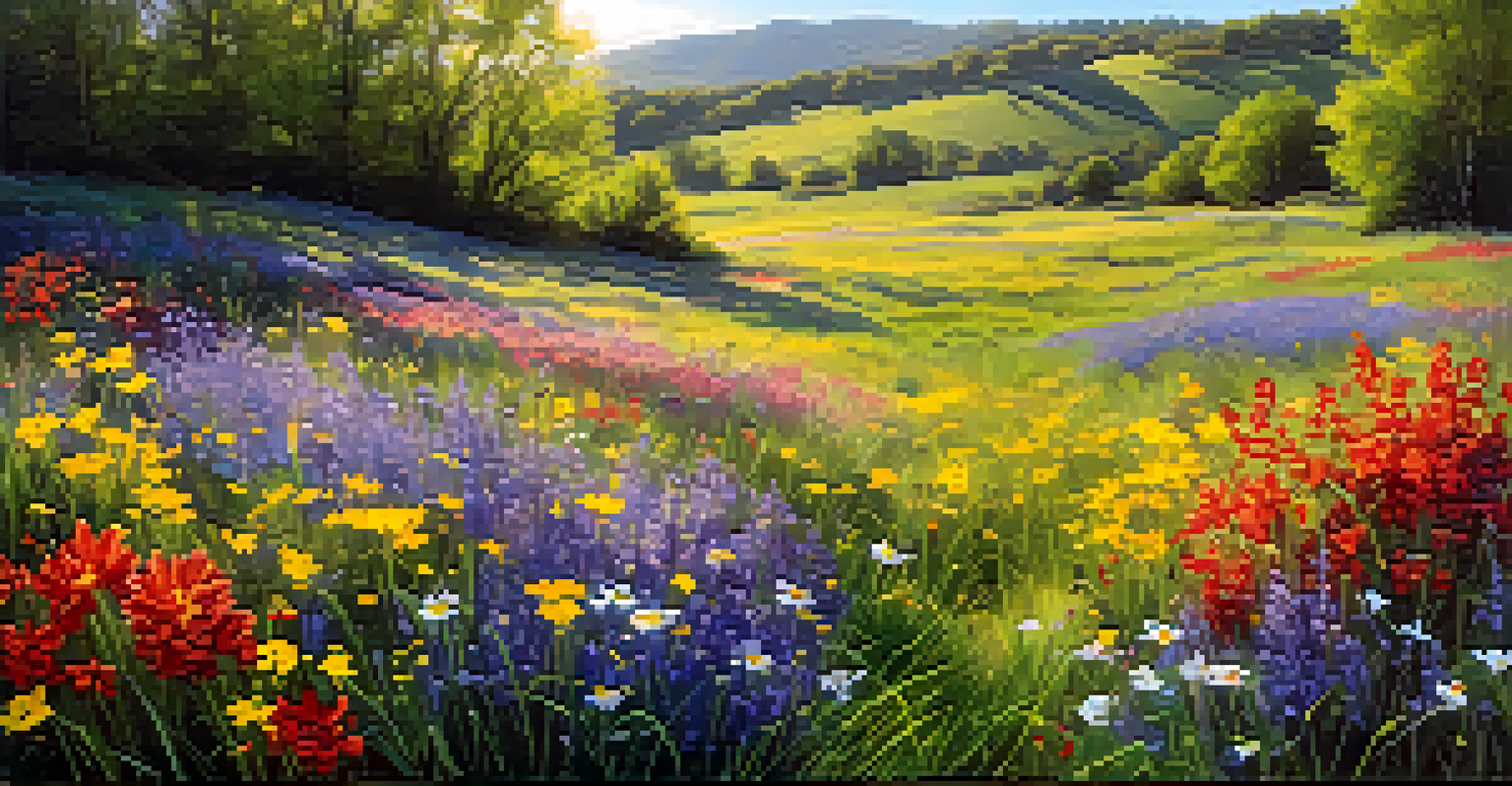Weather Patterns as a Source of Artistic Inspiration

The Relationship Between Weather and Art
Weather has long served as a muse for artists, shaping their creations and inspiring emotions. From the vibrant colors of a sunset to the serene calm after a snowfall, nature's moods have a profound effect on artistic expression. Artists often channel the essence of the weather into their work, making it a central theme or backdrop that resonates with viewers.
The painter's only master is nature.
For instance, think of Claude Monet's 'Impression, Sunrise,' which captures the fleeting beauty of a dawn in a way that evokes both tranquility and transience. Such pieces remind us that weather is not just a backdrop but a character in the story of our lives, influencing our feelings and our experiences. This dynamic relationship encourages artists to explore the subtleties of weather, inviting audiences to experience their interpretations.
Ultimately, the interplay between weather and art highlights how our surroundings can inspire creativity. Whether through painting, music, or literature, understanding the emotional weight of weather patterns can enrich artistic endeavors, allowing for a deeper connection between the artist and their audience.
Nature’s Palette: Color and Mood in Weather
Colors in nature, especially those influenced by weather, play a significant role in artistic inspiration. The golden hues of a sunset can evoke feelings of warmth and nostalgia, while stormy skies may elicit emotions of drama and tension. Artists often utilize these colors to convey specific moods, drawing viewers into their emotional landscapes.

For example, Vincent van Gogh's 'Starry Night' showcases swirling blues and yellows that reflect a turbulent night sky, capturing both chaos and beauty. Such artistic choices remind us that color is not just aesthetic; it is a powerful tool for expression that can communicate feelings without the need for words. The shifting colors of nature can thus deeply influence the emotional tone of a piece.
Weather Inspires Artistic Expression
Artists draw upon the moods and colors of weather to create works that resonate emotionally with audiences.
By observing how weather transforms landscapes, artists can find inspiration in the ever-changing hues of the world around them. This exploration of color and mood can lead to innovative techniques and styles, ultimately enriching the viewer's experience and expanding the conversation around nature's influence in art.
Weather as a Narrative Device in Literature
In literature, weather often acts as a narrative device, setting the stage for the emotions and actions of characters. Rain might symbolize sadness or reflection, while bright sunshine could indicate hope or joy. Authors cleverly weave weather patterns into their stories to enhance the atmosphere and deepen the reader's connection to the characters.
Art is the most beautiful of all lies.
Consider the use of a storm in Shakespeare's 'The Tempest,' where the tumultuous weather mirrors the inner turmoil of the characters. Such parallels create a rich tapestry of meaning, allowing readers to feel the weight of the weather alongside the characters' journeys. This connection between weather and emotion can elevate a narrative, making it more engaging and relatable.
By tapping into the symbolic nature of weather, writers can explore complex themes and emotions, giving readers a multi-dimensional experience. The weather becomes more than just a setting; it transforms into a vital element that adds layers of meaning to the narrative.
Music Inspired by Weather: Soundscapes of Nature
Music has a unique ability to capture the essence of different weather conditions, translating them into sound. Composers often draw inspiration from the natural world, creating pieces that evoke the sounds of rain, thunder, or the gentle rustle of leaves in the wind. These soundscapes can transport listeners to a specific moment, enhancing their emotional connection to the music.
Take, for example, Debussy's 'Clair de Lune,' which is often associated with serene moonlit nights and soft breezes. The delicate melodies and harmonies mimic the tranquility of a clear night, inviting listeners to relax and reflect. This ability to create mood through sound illustrates how weather can influence not just what we see, but also what we hear and feel.
Emotional Connections Through Weather
The interplay between weather and art allows creators to express complex feelings, fostering a deeper connection with viewers.
By incorporating weather into their compositions, musicians can create immersive experiences that resonate with audiences on a personal level. Whether it's the lively energy of a summer storm or the peacefulness of a snowy day, the interplay of music and weather can evoke powerful emotions and memories.
Visual Arts: Capturing Ephemeral Weather Moments
In visual arts, capturing the fleeting moments of weather can be both challenging and rewarding. Artists often strive to depict the ephemeral nature of weather, whether it's the soft glow of a sunrise or the dramatic shadows of storm clouds. This pursuit can lead to stunning representations that invite viewers to appreciate the beauty of the moment.
For example, impressionist painters like Monet and Renoir masterfully captured the effects of light and atmosphere in their works, often painting outdoors to seize the transient qualities of weather. Their ability to convey movement and change in the environment resonates with audiences, reminding us of the beauty inherent in impermanence. This technique encourages a deeper appreciation for the world around us.
By embracing the unpredictability of weather, visual artists can explore new techniques and perspectives, pushing the boundaries of their creativity. The challenge of capturing these moments can lead to innovative approaches that enrich the artistic landscape.
The Influence of Climate on Artistic Movements
Throughout history, different climates have influenced artistic movements, shaping the styles and themes of various cultures. For instance, the bright, sunny landscapes of the Mediterranean inspired the vibrant colors of post-impressionism, while the moody, fog-laden settings of Northern Europe gave rise to darker, more introspective works. This geographical connection to weather can deeply impact artistic expression.
Consider how the light and colors of the South of France attracted artists like van Gogh and Cézanne, who infused their works with the energy and warmth of their surroundings. These regional influences remind us that weather is not just a backdrop but a catalyst for creativity, shaping the identities of artistic communities over time. This relationship encourages artists to draw from their local environments.
Nature Shapes Artistic Movements
Different climates and landscapes have historically influenced artistic styles and themes, impacting cultural expression.
As artists continue to explore the interplay between climate and creativity, they can discover new themes and techniques that reflect their unique experiences. This ongoing dialogue between weather and art highlights the importance of place in shaping artistic movements and individual expression.
Emotional Responses to Weather in Art
Artists often channel their emotional responses to weather into their work, using it as a medium to express feelings and experiences. The impact of a rainy day, for instance, might evoke feelings of melancholy, which can be transformed into a poignant painting or a haunting melody. This emotional connection between weather and art allows for a deeper exploration of the human experience.
For example, the melancholic atmosphere of a foggy landscape can inspire introspective themes in literature or visual arts, prompting both artists and audiences to reflect on their emotions. This shared experience creates a sense of connection, as viewers recognize their own feelings mirrored in the artwork. It also emphasizes how deeply intertwined our emotions are with the natural world.

By tapping into these emotional responses, artists can create powerful works that resonate with audiences on a personal level. This exploration of feelings and weather enhances the overall impact of their creations, allowing for a rich dialogue between the art and its viewers.
Weather: A Timeless Source of Artistic Inspiration
As we’ve explored, weather patterns serve as a timeless source of inspiration across various artistic disciplines. From visual arts to literature and music, the influence of nature's moods can be seen in countless works that evoke strong emotions and reflections. This connection between weather and creativity is not just a fleeting trend; it’s a fundamental part of the human experience.
Artists continue to look to the skies for inspiration, finding new ways to interpret the ever-changing weather and its impact on our lives. Whether through the vibrant colors of a sunset or the somber tones of a stormy night, the artistic expressions derived from weather patterns invite us to slow down and appreciate the beauty around us.
Ultimately, the relationship between weather and art encourages us to engage with our surroundings and find inspiration in the world we inhabit. As we move forward, the interplay between nature and creativity will undoubtedly continue to inspire future generations of artists, ensuring that this rich dialogue remains alive and vibrant.